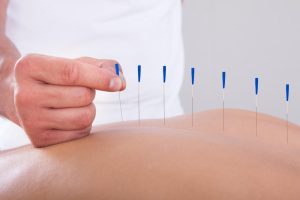 Acupuncture is a key component of Traditional Chinese medicine. It is a safe therapeutic treatment that involves inserting fine, metallic sterile needles through the skin at strategic points on your body. The needles can be left in place for a period of time or activated through gentle and specific movements of the practitioner’s hands or with electrical stimulation.
Acupuncture is a key component of Traditional Chinese medicine. It is a safe therapeutic treatment that involves inserting fine, metallic sterile needles through the skin at strategic points on your body. The needles can be left in place for a period of time or activated through gentle and specific movements of the practitioner’s hands or with electrical stimulation.
Traditional Chinese medicine practitioners believe the human body has more than 2,000 acupuncture points connected by pathways or meridians through that energy — known as chi or qi flows in your body that is responsible for overall health. Disruption of the energy flow can cause disease. By applying acupuncture to specific points, acupuncture practitioners believe that the energy flow will re-balance, thereby improving health.
In contrast, many Western practitioners view the acupuncture points as places to stimulate nerves, muscles and connective tissue, and this stimulation boosts your body’s natural painkillers, improves local circulation and accelerates the healing process.
Studies have shown that acupuncture is effective for a variety of conditions
• Chemotherapy-induced and postoperative nausea and vomiting
• Dental pain
• Sinusitis
• Seasonal allergies
• Fibromyalgia
• Headaches, including tension headaches and migraines
• Nerve pain
• Labor pain
• Lower back pain and sciatica
• Neck pain
• Osteoarthritis
• Menstrual cramps and post-menopause syndrome
• Tennis elbow
• Weight loss
Types of Acupuncture
• Traditional Chinese Acupuncture
• Electroacupuncture, is commonly used to relieve chronic pain. The therapist connects the acupuncture needles and the electronic device by using small clips. The charge improves the blood supply and triggers the body’s natural pain relief. It also boosts energy flow between both points.
• Intramuscular stimulation (IMS), is an effective method in the treatment of chronic pain associated with neuropathies and shortened muscles. The practitioner inserts and moves a fine needle in certain points in muscles to release the shortened muscle which presses on and irritates the nerve.
• Dry needling (DN) can be extremely effective for acute and chronic trigger points. Trigger points are hyper tight band in muscles that can cause acute or chronic pain. This pain is often called “myofascial pain”.
• Cupping Acupuncture involves using glass suction cups to stimulate blood flow to specific points in the body, and usually performed with needle acupuncture. The cups stay on the skin surface for a period of time. Cupping helps reduce muscle pain and inflammation, and eliminate toxins in the blood flow. By redirecting the flow of blood, the blood vessels expand that causes your skin to redden. The redness will disappear after approximately ten days.
